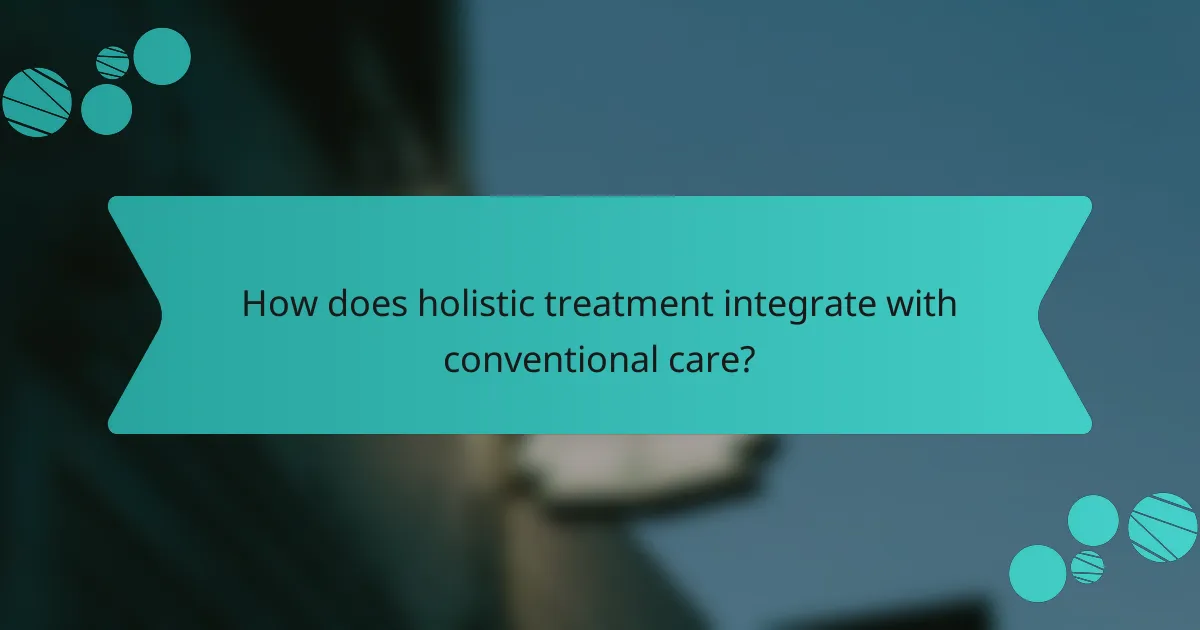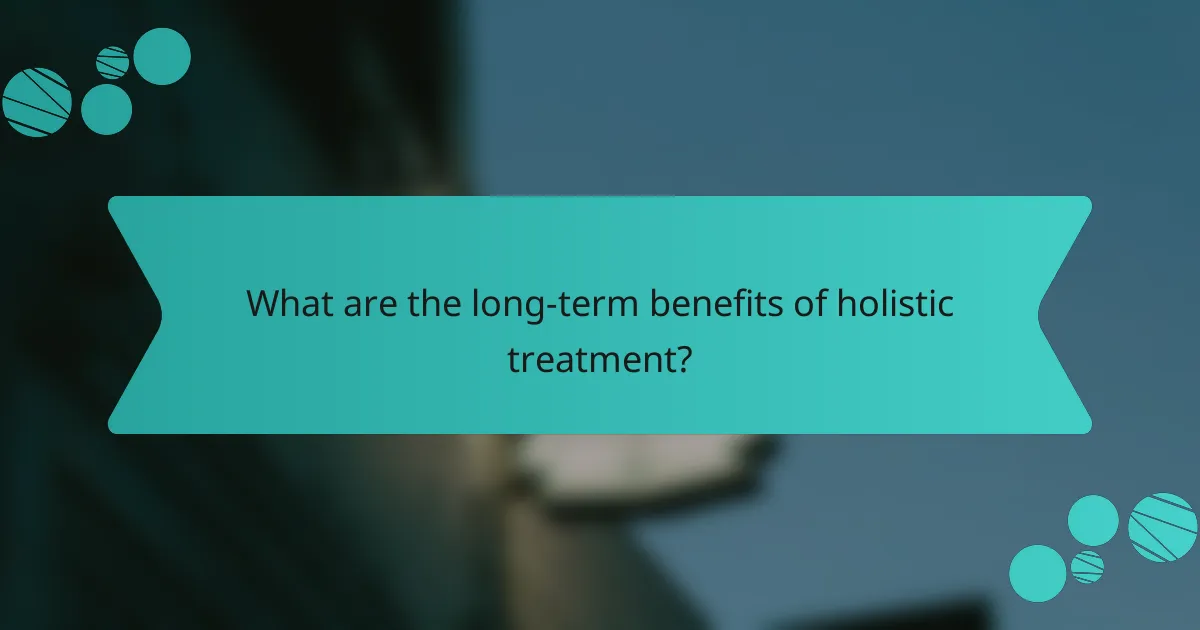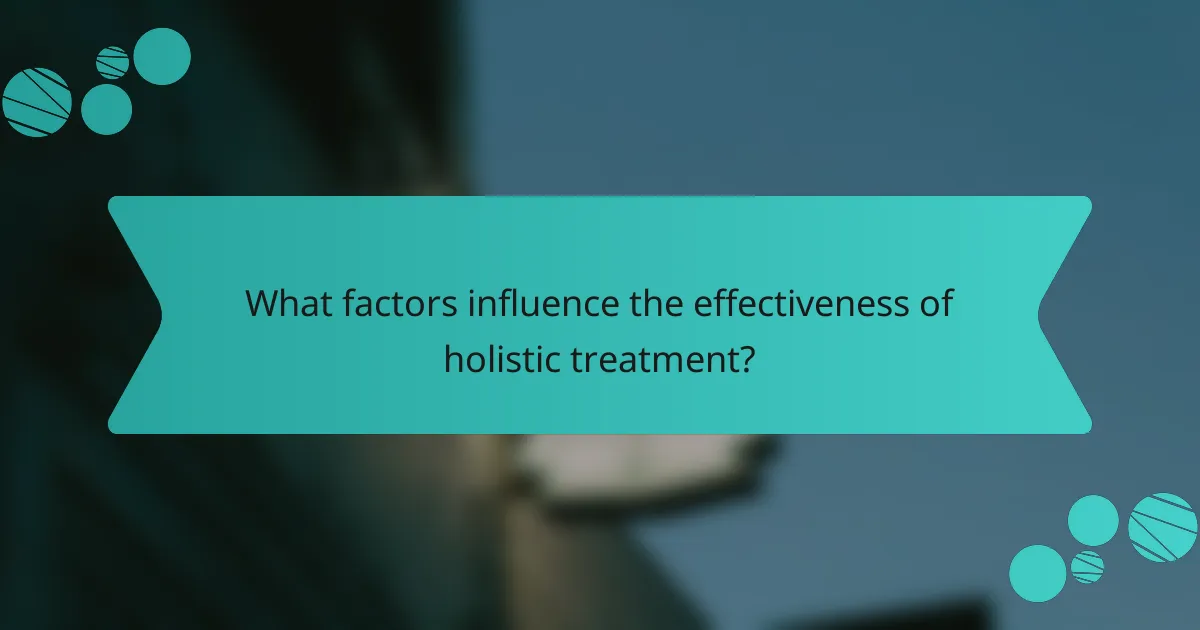Holistic treatment in Canada provides a comprehensive approach that focuses on the interconnectedness of physical, mental, and emotional health, resulting in enhanced overall well-being. Patients often share testimonials highlighting the positive outcomes and long-term benefits they experience when holistic therapies are integrated with conventional medical care.

How does holistic treatment benefit patients in Canada?
Holistic treatment in Canada offers patients a comprehensive approach that addresses physical, mental, and emotional health, leading to improved overall well-being. By integrating various therapies, patients often experience long-term benefits that complement conventional medical care.
Improved mental health
Holistic treatment can significantly enhance mental health by incorporating practices such as mindfulness, meditation, and counseling. These methods help reduce stress, anxiety, and depression, promoting a more balanced emotional state.
Patients often report feeling more in control of their mental health, as holistic approaches encourage self-awareness and coping strategies. This empowerment can lead to a decrease in reliance on medication for mental health issues.
Enhanced physical well-being
Physical health benefits from holistic treatment through techniques like acupuncture, massage therapy, and nutritional counseling. These therapies can alleviate chronic pain, improve mobility, and boost immune function.
For instance, patients with conditions like arthritis may find relief through a combination of physical therapy and dietary adjustments. This integrated approach can lead to better management of symptoms and improved quality of life.
Increased patient satisfaction
Holistic treatment often results in higher patient satisfaction due to its personalized nature. Patients appreciate the attention given to their unique needs and preferences, which fosters a stronger patient-provider relationship.
Moreover, the focus on overall wellness rather than just symptom management encourages patients to take an active role in their health. This engagement can lead to better adherence to treatment plans and more positive health outcomes.

What do patient testimonials reveal about holistic treatment?
Patient testimonials about holistic treatment often highlight positive outcomes and improved well-being. Many individuals report enhanced quality of life through a combination of alternative therapies and conventional medicine.
Positive experiences with practitioners
Patients frequently express satisfaction with holistic practitioners who take a comprehensive approach to care. These professionals often spend more time with patients, addressing not just physical symptoms but also emotional and lifestyle factors.
Many testimonials emphasize the supportive environment created by holistic practitioners, which fosters trust and open communication. This rapport can significantly enhance the overall treatment experience and encourage patients to engage more fully in their healing journey.
Success stories of recovery
Numerous success stories illustrate how holistic treatment has led to significant recoveries, particularly in chronic conditions. Patients have reported reductions in pain, improved mental health, and better management of conditions like anxiety, depression, and autoimmune disorders.
For example, individuals with chronic pain have shared experiences of combining acupuncture and nutritional counseling with traditional pain management, resulting in a more sustainable and effective approach to their health. These narratives often highlight the importance of personalized treatment plans tailored to individual needs.

How does holistic treatment integrate with conventional care?
Holistic treatment integrates with conventional care by addressing the whole person—mind, body, and spirit—while complementing standard medical practices. This approach enhances patient outcomes by combining traditional therapies with alternative methods tailored to individual needs.
Complementary therapies
Complementary therapies include practices such as acupuncture, massage, and herbal medicine that can enhance the effectiveness of conventional treatments. For example, acupuncture may help alleviate pain and reduce anxiety for patients undergoing surgery or chemotherapy.
When considering complementary therapies, it’s essential to consult healthcare providers to ensure safety and compatibility with existing treatments. Patients should look for practitioners who are licensed and experienced in their respective fields.
Collaborative care models
Collaborative care models involve a team of healthcare professionals working together to provide comprehensive treatment plans that incorporate both conventional and holistic approaches. This may include doctors, nurses, nutritionists, and mental health professionals coordinating care for the best patient outcomes.
Effective communication among team members is crucial for the success of collaborative care. Patients should actively participate in discussions about their treatment options and express their preferences regarding holistic therapies to ensure their needs are met.

What are the long-term benefits of holistic treatment?
Holistic treatment offers various long-term benefits, including improved overall health and enhanced quality of life. By addressing the physical, emotional, and spiritual aspects of well-being, patients often experience sustained improvements that complement conventional medical care.
Sustained health improvements
Holistic treatment focuses on the whole person, which can lead to lasting health improvements. Techniques such as mindfulness, nutrition, and physical therapies can enhance immune function and reduce stress, contributing to better long-term health outcomes.
For instance, individuals who adopt a holistic approach may find that their energy levels stabilize, and they experience fewer illnesses. Regular practices like yoga or meditation can also promote mental clarity and emotional resilience over time.
Better management of chronic conditions
Holistic treatment can significantly improve the management of chronic conditions by integrating lifestyle changes with conventional therapies. Patients often report reduced symptoms and enhanced coping strategies when they combine dietary adjustments, exercise, and stress management techniques.
For example, someone with diabetes may benefit from a holistic approach that includes a balanced diet, regular physical activity, and mindfulness practices, leading to better blood sugar control. This comprehensive strategy can reduce the reliance on medication and improve overall well-being.

What factors influence the effectiveness of holistic treatment?
The effectiveness of holistic treatment is influenced by several key factors, including patient engagement and the quality of practitioners involved. These elements can significantly affect outcomes and the overall experience of the treatment process.
Patient engagement
Active participation from patients is crucial for the success of holistic treatment. When patients are engaged, they are more likely to adhere to treatment plans and make lifestyle changes that complement their care.
Strategies to enhance patient engagement include setting clear goals, providing educational resources, and encouraging open communication. For instance, patients who track their progress or participate in support groups often report better outcomes.
Quality of practitioners
The expertise and approach of practitioners play a vital role in the effectiveness of holistic treatment. Practitioners should be well-trained in both holistic methods and conventional practices to provide comprehensive care.
When selecting a practitioner, consider their qualifications, experience, and patient reviews. A skilled practitioner not only applies techniques effectively but also fosters a trusting relationship, which can enhance the healing process.

What are the challenges of integrating holistic and conventional care?
Integrating holistic and conventional care presents several challenges, primarily related to insurance coverage and regulatory frameworks. These obstacles can hinder patient access to comprehensive treatment options that combine both approaches effectively.
Insurance coverage issues
One significant challenge is that many insurance plans do not cover holistic treatments, which can include therapies like acupuncture, chiropractic care, or nutritional counseling. Patients may find themselves paying out-of-pocket for these services, leading to increased financial strain.
To navigate this issue, patients should review their insurance policies carefully and inquire about coverage for specific holistic treatments. Some providers may offer payment plans or sliding scale fees to make these services more accessible.
Regulatory barriers
Regulatory barriers can complicate the integration of holistic and conventional care. Different states or countries may have varying regulations regarding the practice of holistic therapies, affecting how practitioners can operate and collaborate with conventional healthcare providers.
Patients should be aware of local regulations that govern holistic practices. Engaging with practitioners who are familiar with these regulations can help ensure that they receive safe and compliant care that complements their conventional treatment.
